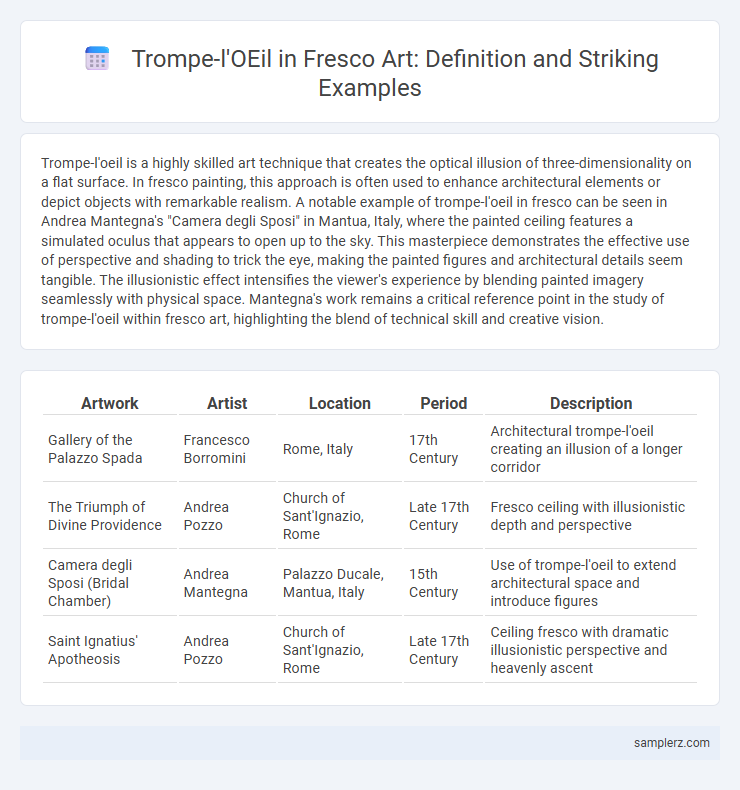Trompe-l'oeil is a highly skilled art technique that creates the optical illusion of three-dimensionality on a flat surface. In fresco painting, this approach is often used to enhance architectural elements or depict objects with remarkable realism. A notable example of trompe-l'oeil in fresco can be seen in Andrea Mantegna's "Camera degli Sposi" in Mantua, Italy, where the painted ceiling features a simulated oculus that appears to open up to the sky. This masterpiece demonstrates the effective use of perspective and shading to trick the eye, making the painted figures and architectural details seem tangible. The illusionistic effect intensifies the viewer's experience by blending painted imagery seamlessly with physical space. Mantegna's work remains a critical reference point in the study of trompe-l'oeil within fresco art, highlighting the blend of technical skill and creative vision.
Table of Comparison
| Artwork | Artist | Location | Period | Description |
|---|---|---|---|---|
| Gallery of the Palazzo Spada | Francesco Borromini | Rome, Italy | 17th Century | Architectural trompe-l'oeil creating an illusion of a longer corridor |
| The Triumph of Divine Providence | Andrea Pozzo | Church of Sant'Ignazio, Rome | Late 17th Century | Fresco ceiling with illusionistic depth and perspective |
| Camera degli Sposi (Bridal Chamber) | Andrea Mantegna | Palazzo Ducale, Mantua, Italy | 15th Century | Use of trompe-l'oeil to extend architectural space and introduce figures |
| Saint Ignatius' Apotheosis | Andrea Pozzo | Church of Sant'Ignazio, Rome | Late 17th Century | Ceiling fresco with dramatic illusionistic perspective and heavenly ascent |
Introduction to Trompe-l’Œil in Fresco Art
Trompe-l'OEil in fresco art creates an optical illusion that deceives the viewer into perceiving painted details as three-dimensional objects. Notable examples include Andrea Mantegna's Camera degli Sposi in Mantua, where architectural elements appear to extend beyond the wall surface, and the Baroque frescoes of Giovanni Battista Tiepolo, which transform ceilings into open skies filled with dynamic figures. These masterpieces demonstrate the technique's effectiveness in blending painted imagery with real space to enhance visual depth.
Historical Origins of Trompe-l’Œil Frescoes
Trompe-l'oeil frescoes trace their historical origins to ancient Roman wall paintings, where artisans meticulously rendered architectural elements to create optical illusions of depth and space. The technique flourished during the Renaissance, exemplified by Andrea Mantegna's Ceiling of the Palazzo Ducale in Mantua, showcasing groundbreaking perspective mastery. These frescoes laid the foundation for modern trompe-l'oeil art by combining precise geometry with vivid realism to deceive viewers' perception.
Key Techniques behind Trompe-l’Œil Fresco Illusions
Trompe-l'oeil frescoes achieve their striking realism through key techniques such as precise linear perspective, chiaroscuro to create depth, and meticulous attention to texture and detail that mimic real materials. Artists skillfully manipulate light and shadow to deceive the eye, making painted objects appear three-dimensional and tangible. Mastery in foreshortening also enhances the illusion, allowing flat surfaces to visually recede or protrude convincingly as sculptural forms.
The Frescoes of Andrea Pozzo: Masterpieces of Deception
Andrea Pozzo's frescoes in the Church of Sant'Ignazio in Rome showcase extraordinary trompe-l'oeil techniques, creating the illusion of three-dimensional architectural space on flat surfaces. His ceiling fresco, depicting the Apotheosis of Saint Ignatius, employs perspective mastery that tricks the eye into perceiving an open sky and soaring figures. Pozzo's work remains a paramount example of Baroque illusionism, demonstrating how trompe-l'oeil can transform interior spaces through painted deception.
Giovanni Battista Tiepolo’s Architectural Illusions
Giovanni Battista Tiepolo's Architectural Illusions showcase masterful trompe-l'oeil fresco techniques, creating convincing three-dimensional architectural features on flat surfaces. These frescoes employ precise perspective and shading to simulate depth, exemplified in works like the Palazzo Labia ceiling in Venice. Tiepolo's use of illusionistic elements enhances spatial perception and immerses viewers in grand architectural environments.
Renaissance Ceiling Frescoes: Depth and Perspective
Renaissance ceiling frescoes such as Andrea Mantegna's Camera degli Sposi showcase trompe-l'oeil techniques that create convincing illusions of depth and three-dimensional space. The use of perspective in works like Giulio Romano's Palazzo del Te frescoes manipulates architectural elements to blend painted space with actual room structure. These masterpieces exemplify how trompe-l'oeil innovations during the Renaissance enhanced visual immersion and spatial realism on flat surfaces.
Notable Trompe-l’Œil Frescoes in Italian Churches
Notable trompe-l'oeil frescoes in Italian churches include Andrea Pozzo's masterpiece in the Church of St. Ignatius in Rome, where the ceiling transforms into an illusionistic architectural space that appears to extend infinitely upwards. Another exemplary work is the vaulted ceiling fresco at Sant'Ignazio, featuring fake dome illusionism that enhances the spatial perception within the Baroque church. These frescoes are celebrated for their extraordinary use of perspective and foreshortening, creating compelling visual deceptions that integrate art and architecture seamlessly.
Classical Themes in French Trompe-l’Œil Frescoes
French trompe-l'oeil frescoes often incorporate Classical themes such as mythological figures, architectural elements, and intricate ornamentation to create convincing illusions of depth and space. Notable examples include the Palace of Versailles, where artists like Jean-Baptiste Oudry painted lifelike depictions of gods, goddesses, and classical motifs to blur the boundaries between reality and artifice. These frescoes exemplify the mastery of perspective and detail characteristic of 17th and 18th-century French decorative art.
Trompe-l’Œil in Modern Fresco Revival
Trompe-l'OEil techniques in the modern fresco revival incorporate hyper-realistic imagery to create optical illusions that challenge viewers' perceptions of space and form. Contemporary artists often use vivid color contrasts and meticulous shading to simulate three-dimensional architectural elements or objects on flat fresco surfaces. These modern interpretations breathe new life into the Renaissance tradition, blending classic craftsmanship with innovative visual effects in urban and public art installations.
Iconic Trompe-l’Œil Frescoes: A Gallery of Examples
Iconic trompe-l'oeil frescoes such as Andrea Mantegna's "Camera degli Sposi" in Mantua showcase astonishing illusionistic techniques that create three-dimensional architectural effects on flat surfaces. Another notable example is the ceiling fresco in the Palazzo Spada in Rome by Francesco Borromini, where forced perspective tricks viewers into perceiving great depth within a small space. These masterpieces exemplify trompe-l'oeil's power to manipulate perception through meticulous detail and spatial distortion in Renaissance and Baroque art.

example of trompe-l'œil in fresco Infographic
 samplerz.com
samplerz.com